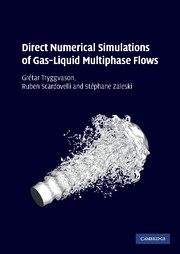Refine search
Actions for selected content:
2584 results in Computational Science
Preface to the first edition
-
- Book:
- Data Analysis for Physical Scientists
- Published online:
- 05 March 2012
- Print publication:
- 16 February 2012, pp xiii-xvi
-
- Chapter
- Export citation
Index
-
- Book:
- Data Analysis for Physical Scientists
- Published online:
- 05 March 2012
- Print publication:
- 16 February 2012, pp 506-510
-
- Chapter
- Export citation
Chapter 1 - Introduction to scientific data analysis
-
- Book:
- Data Analysis for Physical Scientists
- Published online:
- 05 March 2012
- Print publication:
- 16 February 2012, pp 1-39
-
- Chapter
- Export citation
Chapter 2 - Excel and data analysis
-
- Book:
- Data Analysis for Physical Scientists
- Published online:
- 05 March 2012
- Print publication:
- 16 February 2012, pp 40-89
-
- Chapter
- Export citation
Chapter 9 - Tests of significance
-
- Book:
- Data Analysis for Physical Scientists
- Published online:
- 05 March 2012
- Print publication:
- 16 February 2012, pp 382-427
-
- Chapter
- Export citation
Frontmatter
-
- Book:
- Data Analysis for Physical Scientists
- Published online:
- 05 March 2012
- Print publication:
- 16 February 2012, pp i-v
-
- Chapter
- Export citation
Chapter 5 - Measurement, error and uncertainty
-
- Book:
- Data Analysis for Physical Scientists
- Published online:
- 05 March 2012
- Print publication:
- 16 February 2012, pp 168-225
-
- Chapter
- Export citation
Appendix 2 - Propagation of uncertainties
-
- Book:
- Data Analysis for Physical Scientists
- Published online:
- 05 March 2012
- Print publication:
- 16 February 2012, pp 453-454
-
- Chapter
- Export citation
Chapter 7 - Least squares II
-
- Book:
- Data Analysis for Physical Scientists
- Published online:
- 05 March 2012
- Print publication:
- 16 February 2012, pp 297-334
-
- Chapter
- Export citation
Chapter 10 - Data Analysis tools in Excel and the Analysis ToolPak
-
- Book:
- Data Analysis for Physical Scientists
- Published online:
- 05 March 2012
- Print publication:
- 16 February 2012, pp 428-443
-
- Chapter
- Export citation
Medians and means in Finsler geometry
- Part of
-
- Journal:
- LMS Journal of Computation and Mathematics / Volume 15 / May 2012
- Published online by Cambridge University Press:
- 01 February 2012, pp. 23-37
-
- Article
-
- You have access
- Export citation

Mathematics of Choice
- Or How to Count without Counting
-
- Published by:
- Mathematical Association of America
- Published online:
- 05 January 2012
- Print publication:
- 01 June 1965
-
- Book
- Export citation
Dimension reduction and homogenization of random degenerate operators. Part I
- Part of
-
- Journal:
- LMS Journal of Computation and Mathematics / Volume 15 / May 2012
- Published online by Cambridge University Press:
- 01 January 2012, pp. 1-22
-
- Article
-
- You have access
- Export citation
Involutions in Janko’s simple group J4
- Part of
-
- Journal:
- LMS Journal of Computation and Mathematics / Volume 14 / 2011
- Published online by Cambridge University Press:
- 01 November 2011, pp. 238-253
-
- Article
-
- You have access
- Export citation
Abelian functions associated with genus three algebraic curves
- Part of
-
- Journal:
- LMS Journal of Computation and Mathematics / Volume 14 / 2011
- Published online by Cambridge University Press:
- 01 November 2011, pp. 291-326
-
- Article
-
- You have access
- Export citation
Efficient nonlinear filtering of a singularly perturbed stochastic hybrid system
- Part of
-
- Journal:
- LMS Journal of Computation and Mathematics / Volume 14 / 2011
- Published online by Cambridge University Press:
- 01 November 2011, pp. 254-270
-
- Article
-
- You have access
- Export citation
Proving the Birch and Swinnerton-Dyer conjecture for specific elliptic curves of analytic rank zero and one
- Part of
-
- Journal:
- LMS Journal of Computation and Mathematics / Volume 14 / 2011
- Published online by Cambridge University Press:
- 01 November 2011, pp. 327-350
-
- Article
-
- You have access
- Export citation
Decomposition matrices for d-Harish-Chandra series: the exceptional rank two cases
- Part of
-
- Journal:
- LMS Journal of Computation and Mathematics / Volume 14 / 2011
- Published online by Cambridge University Press:
- 01 November 2011, pp. 271-290
-
- Article
-
- You have access
- Export citation

Direct Numerical Simulations of Gas–Liquid Multiphase Flows
-
- Published online:
- 07 October 2011
- Print publication:
- 10 March 2011
Preface
-
- Book:
- Greedy Approximation
- Published online:
- 05 August 2012
- Print publication:
- 08 September 2011, pp ix-xiv
-
- Chapter
- Export citation
